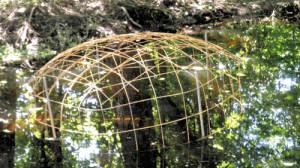Bridgton beavers’ saga continues
By Gail Geraghty
Staff Writer

A CAGEY WAY — to prevent the beavers from plugging up the upstream end of the culvert was to erect this wire dome over it, held in place by rebar sunk deep into the stream bed.
A grand experiment in coexistence with beavers began last weekend when a few passionate folks waded knee-deep in muck to modify the dam the beavers created behind the Bridgton Post Office on Elm Street.
The dam was causing flooding in the post office’s parking lot, and raised water levels well above what’s typical for a large expanse of downtown wetland bounded by Elm, Park and Nulty Streets and the town’s Wayside Avenue leach field.
Regional Wildlife Biologist Scott Lindsay of the Maine Department of Inland Fisheries and Wildlife believes it’s one or two young beavers at work, possibly the same ones that built the lodge and dam just a short distance away at Shorey Park, where Highland Lake meets Stevens Brook. Resident Lega Medcalf, who’s been championing the beavers’ cause, called Lindsay for advice about the problem, and he put her in contact with Richard Hesslein of Brownfield, who has worked on beaver modification efforts for years. Together, they walked the perimeter of the wetland around Corn Shop Brook late last week.
To trap or not to trap
Lindsay favored trapping and relocating the beavers, given the amount of development in the area. It’s unlikely the beavers would stick around, he said, if humans start messing around with what they’ve built. They couldn’t find any evidence of a lodge, but with such a large wetland, Lindsay said it’s likely they’re just laying low for now, planning their next move.
“They like to raise the water level up so they can feed on the trees, because they don’t like to go more than 20 feet from water,†he said. If there’s too much water drainage or other disturbance to the habitat they’ve created, it could drive them away, Lindsay said.
Nevertheless, Hesslein said he wanted to at least try for coexistence, by installing a water leveler at the dam. A large length of culvert was laid in the brook over the dam, after Lindsay took a chain saw to cut a sizable notch in the middle of the dam. Interestingly, packed in with the mass of mud and sticks they removed from the dam were such items as a tape player and broken shards of glass. A wire dome cage was secured with rebar over the upstream end of the culvert to prevent the beavers from plugging it up. “When they hear the sound of running water, it stimulates them to build,†Lindsay said.
There’s a sizable bend in the culvert over the dam, and Lindsay has offered to remove more dam material so that the culvert will lay parallel to the water surface and enhance the flow of water. In order to succeed, the beavers have to build up the dam to hold the levelers in place.
“I hope it goes well,†Lindsay said. “I do appreciate the efforts of Lega and Rick. Though Rick and I have our differences on beaver management, we agree on the potential ecological value of their work.â€
Better to modify than move them out
Hesslein believes that simply moving the beavers out, without changing the habitat, would only encourage different beavers to move in. It’s better to modify the habitat as the beavers have engineered it, in order to control flooding, and with luck the beavers will stay, build a lodge (if they haven’t already) and have offspring to continue the cycle, he said.
Hesslein became interested in protecting beavers 12 years ago, when he began quarrying gravel at his Perry Mountain Road property to control road flooding. The beavers created a wetland where there once was meadow, which was fine with him; but after spending $6,000 to make the road stand up to a higher water level, his neighbor killed the beavers because he was concerned about his trees, Hesslein said.
So, with Lindsay’s guarded blessing, Hesslein went to work. “We’re trying to use this as a pilot project to show that it can be a cost effective way of dealing with beavers,†Lindsay said. Having beavers around, he said, is “usually a very positive thing for wildlife,†whether in the wild or right in the middle of town.
Hesslein agrees wholeheartedly. Even though it’s a downtown location, he said, “There’s always been a wetland there, it just didn’t have water on it.†Allowing the beavers to stay will enhance, not detract, from the wetland, said Hesslein. The higher water level has already attracted a family of mallard ducks, and Medcalf said she saw a six-inch fish in the brook while she was removing sticks from the dam. “The amount of wildlife is quite astounding,†she said. Janice Chadbourne, who lives on the top of Elm Street, was one of several property owners who gave their permission for Hesslein to install the water levering device. “She loves wildlife,†said Medcalf, noting that among beaver enthusiasts, the catch phrase is “watchable wildlife.â€
‘All in favor of trying’
“I’m all in favor of trying,†said Lindsay. “In fact, I wish it was more common,†to install water-leveling devices, instead of the tendency — especially in southern Maine — to trap and kill, without even considering whether dam modification could be a more cost-effective solution. “The resistance (to coexistence) may just be from not knowing that the option is there,†Lindsay said. He said water-leveling devices and other beaver dam modification efforts are more common in northern Maine, and are in particular used to protect roads on paper company lands.
But Hesslein, who is aware that “as little as a snowmobile trail can cause beaver to be killed,†knew there was another way. Immediately, he set to work on procuring the needed materials and obtaining the necessary permissions. He hit pay dirt when he appealed to the manager of the Bridgton Paris Farmers’ Union. Store Manager Kathy O’Neil enthusiastically embraced his cause, donating two long lengths of single-walled culvert and the coupler connection. “The equivalent value is around $200-$250 per section,†said Hesslein. Neither he nor Medcalf would have been able to take on the project without the PFU’s help, they said.
They also needed landowners’ permission. They got it from the owner of the post office, the Parsons Corp., and from Jeff Raymond, who manages the adjacent building housing Chandler Funeral Homes. Both were willing to let Hesslein give his project a try, and have agreed at Hesslein’s request to post their land against trapping. Hesslein hopes that willingness will extend to other property owners with frontage on the brook.
On the other side of the brook, where houses and an apartment building are at only a slightly higher elevation than the wetland, Hesslein said the beavers could cause some water problems. But he hopes the beavers will eventually build farther upstream to eliminate the potential for problems there. Permission was also needed from the town, which has property extending from the brook to its Wayside Avenue leachfield.
Medcalf said Public Works Director Jim Kidder has given his blessing to the project. She said he has also agreed to periodically keep an eye on the culvert, to make sure it continues to exist as a flowage.
‘Just relax and be happy’
Lindsay said that if the beavers stay, eventually the wetland would become more open, as the sapling trees are thinned out. The beavers will feed and build, feed and build, “until they can’t raise the water level any more, and then they’ll abandon the site.â€
It’s way too early to say whether the project will succeed or fail. Medcalf said she has been approached by three people who want the beavers on their property, and that a total of nearly 90 people attended two events she organized on separate days last month in Bridgton about coexisting with beavers.
“It’s amazing how the beavers are repairing the dam each day,†she said. “Now that things have stabilized, maybe they’ll just relax and be happy.â€

